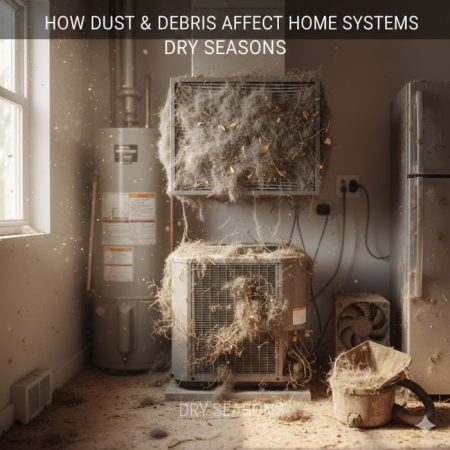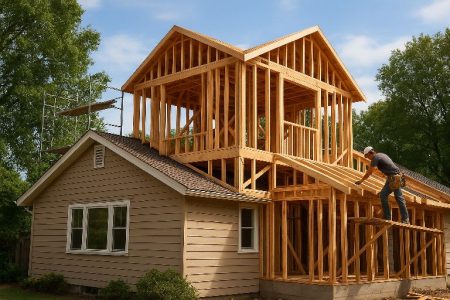One of the best ways to reduce energy costs is to add insulation to your attic. In fact, increasing your attic insulation is often the single most important step you can take to save on heating and cooling costs. Often the easiest way to add insulation to an unfinished attic is to blow loosely filled cellulose or fiberglass insulation.
Blow-In Insulation Foundation
Cellulose is preferred for several reasons. It is an eco-friendly material made from recycled newspapers. It is cheaper than fiberglass, has a higher R-value, and is less irritating to the skin and lungs. Cellulose, also called “natural fiber insulation,” is sold compressed in large plastic bags at home repair shops. The bag must be emptied with a blower, which sends the lint-laden insulation through a long hose. You can usually rent a blower or borrow it from the same store for minimal cost.
Blow-in insulation requires two people. One person fills up the blower and lets it work, and the other works the hose in the attic. But an important task of preparing the attic is something you can do yourself.
Necessary Supplies
- Eye Goggles
- Dust Mask
- Gloves
- Long Sleeve Shirt
- Walkable Plywood Or Planks
- Work Light
- Spray Foam
- Caulking And Caulking Guns
- Ventilation Channels For Houses With Bottom Vents (Preferably Foam)
- Stapler, For Vent Channel Installation
- Meteor Magic
- Tape Measure
- Cellulose Insulation And Blowing Equipment
Air Seal Before Insulation
In older houses, a lot of air leaks through the ceiling into the attic. In summer and winter, you lose air lost because you paid for heating or cooling. So the first task is to seal the leak. This step reduces energy loss without having to worry about blown phosphorus insulation. Air leaks can occur around the following items:
- Chimney
- Plumbing Vents
- HVAC Duct
- Purchase, Etc.
- Exhaust Fan Housing
- Attic Access Hatch
- Area Above The Interior Partition Wall
Before heading to the attic, map these potential leaks downstairs. Use the map to guide you in the attic.
Try laying plywood or planks over the floor joists to provide a temporary walking surface. Be careful not to step between the joists as there is the potential for your feet to enter the drywall ceiling below.
If the attic already has insulation, it should be removed while sealing the leak. Use extended spray foam around 1/4″ spacing. Use caulking for wider, larger or smaller gaps. Fill in all blanks completely.
If your home eaves have underfloor vents, make sure your attic has vents. If not, or if an existing channel is damaged, install a new channel to ensure proper air circulation under the roof. Any rafter space that is ventilated requires a channel. Attach the channels to the roof deck using a stapler.
Determining Required Insulation R-Value
Determine the depth of blown insulation required. The depth will depend on the area you live in and the R-value of the insulation you use. Cellulose typically provides R-38 at 10 inches deep.
You can check the maps provided by the Department of Energy to determine the level of insulation you need or to get specific recommendations using: Zip Code Isolation Calculator.
Use a tape measure and a permanent marker to mark the required depth of blown insulation for vertical truss members or wall studs around the attic space. Measure from the drywall surface, not the top of the joists.
If the attic already has insulation, determine the R value and subtract that amount from the desired total to determine the amount of new insulation required.
Buy Cellulose Insulation And Blowers
Buy a few more bags of cellulose insulation than you think you will need. Unused bags should be able to be returned, avoiding the hassle of rushing to the store if the insulation runs out before completion.
For example, GreenFiber Blow-In Natural Fiber (Cellulose) Insulation comes in a bag measuring 12 x 15 x 24 inches. Achieving an R-38 in an attic without conventional insulation would require 60 bags of cellulose insulation for every 1,000 square feet of surface it covers. Low’s and Home Depot offer a free rental of a blower (including 100 feet of hose) with this amount of insulation.
Prepare The Blower Equipment
It is now a two-person job. One person must supply water to the blower and the other must handle the hoses in the attic. Read all instructions provided with the blower. Fill the blower’s hopper about 3/4 full and turn it on.
Remove when loading compressed material, but keep your hands out of the hopper. Some blowers have sliding gates used to control the flow.
Insulation Blown
The person doing the hose work should start at the far end of the attic and work back towards the access hatch. Level the hose approximately 2 feet above the attic floor. It should be able to fill three or four joist bays in one location. You may need to push the hose into the eaves. You can also use the broom handle to push the insulation into hard-to-reach spaces.
Use a sweeping motion to evenly spread the insulation layer up to the depth mark. Always blow in the same direction as the joists. Over time, the insulation will stabilize by an inch or two.
If the blower is clogged, turn off, unplug and remove insulation from hoses and hoppers before continuing. Refill the hopper as needed. Continue the same process until the entire attic floor is filled to the depth mark. If desired, the backside of the attic hatch cover can be insulated with a thick layer of rigid foam insulation or a piece of cellulose batting insulation






